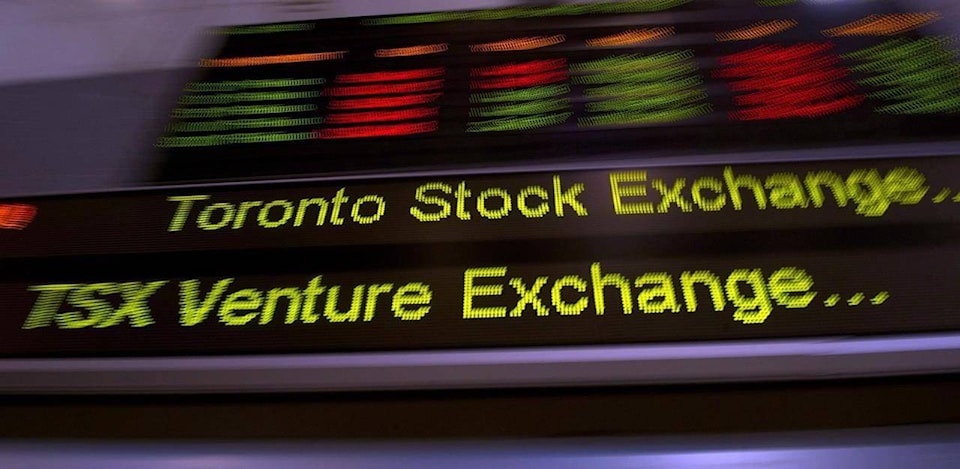TORONTO — Canada’s main stock index posted another triple-digit gain led by a rebound in the technology sector that also pushed most U.S. stock markets higher.
Market activity was calmer midweek than over the previous couple of days, in response to Pfizer’s announcement on Monday that early data shows their coronavirus vaccine was 90 per cent effective in testing.
Part of the lower volume was attributable to bond markets being closed because of the Remembrance and Veterans Day holidays in Canada and the U.S.
“But the trends are still there that there’s a fairly decent bounce-back in the financials and the cyclicals that had been ignored,” said Greg Taylor, chief investment officer of Purpose Investments.
Past rallies by value and cyclical stocks quickly faded away. The fact that they moved higher in the face of rising technology is reassuring, he said.
“It shows that there might be a little more to this bounce in the beat-up cyclical stocks that we haven’t had in a while,” Taylor said in an interview.
If it hadn’t been for the vaccine optimism, rising COVID-19 infections and growing lockdown would have been really negative for sectors that rely on the economy reopening, he said.
“But it does feel like people are becoming more optimistic that 2021 could be a resuming of normalcy in a lot of different areas and that’s certainly not been priced into the market.”
The S&P/TSX composite index closed up 158.77 points to 16,774.14.
In New York, the Dow Jones industrial average was down 23.29 points at 29,397.63. The S&P 500 index was up 27.13 points at 3,572.66, while the Nasdaq composite was up 232.57 points at 11,786.43
Although Joe Biden has been declared the winner of the U.S. presidential election, there is still some election risk with President Donald Trump refusing to concede, Taylor said.
There’s also a risk that companies in beat-up sectors, like travel, will use the reprieve to shore up their cash positions by raising equity as American Airlines did.
That may be a bit of a damper on these sectors but Taylor said it is encouraging to see the lifts enjoyed by life insurers and banks while crude oil rose above US$40 a barrel.
U.S. 10-year bond yields were back Tuesday to the high 90 basis point range for the first time since March on vaccine news.
That optimism will continue to be needed in the face of lockdowns and more restrictions.
“I still think the biggest thing for the TSX is that the banks are starting to act a lot better. And with the banks up half a per cent to one per cent, I think that’s huge validation for a sector that’s really been beaten up,” said Taylor.
Financials was one of 10 sectors on the TSX to move higher on the day, gaining half a per cent, led by Onex Corp., which rose 2.4 per cent.
Technology moved up 3.7 per cent with shares of Shopify Inc. climbing 7.2 per cent.
Industrials was up even though Air Canada shares lost 4.5 per cent after surging nearly 29 per cent on Monday. A 34.6 per cent increase by Great Canadian Gaming Corp. shares helped the consumer discretionary sector.
Energy was up about one percentage point on a continued rise in crude oil prices in anticipation of higher demand should the vaccine be successful. Crescent Point Energy Corp. and Canadian Natural Resources Inc. were each up about three per cent.
The December crude oil contract was up nine cents at US$41.45 per barrel and the December natural gas contract was up 8.2 cents at US$3.03 per mmBTU.
The Canadian dollar traded for 76.55 cents US compared with 76.82 cents US on Tuesday.
Materials was the lone losing sector, falling about a quarter percentage point on lower gold prices.
The December gold contract was down US$14.80 at US$1,861.60 an ounce and the December copper contract was down 2.15 cents at US$3.13 a pound.
After a strong run this year, gold has fallen on higher bond yields and vaccine optimism.
Taylor said he expects gold to stabilize at $1,850 to $1,900 per ounce as it remains a good insurance policy amid economic uncertainty and more fiscal stimulus that could increase inflation.
“Gold is still proving its worth and it is going to be something that people should have in their portfolios going forward.”
This report by The Canadian Press was first published Nov. 11, 2020.
Companies in this story: (TSX:SHOP, TSX:GC, TSX:CPG, TSX:CNQ, TSX:ONEX, TSX:GSPTSE, TSX:CADUSD=X)
Ross Marowits, The Canadian Press
